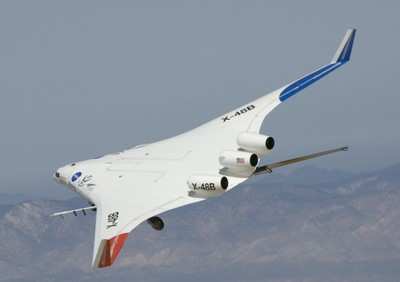Scale Model Of Hybrid Wing Body Aircraft Proves Concept
A team led by NASA and Boeing has completed the first phase of
flight tests on the subscale X-48B blended wing body aircraft at
the agency's Dryden Flight Research Center in Edwards, CA. The
remotely piloted, 500-pound airplane with the silhouette resembling
a manta ray - also called a hybrid wing body - is a tool of NASA's
new Environmentally Responsible Aviation, or ERA, Project, which
aims to develop the technology needed to create a quieter, cleaner,
and more fuel-efficient airplane for the future.

A flying test bed such as the X-48B enables NASA to assess and
validate the key technologies. The recently concluded flight tests
ascertained the handling and flying qualities of such an aircraft
at speeds typical of landings and takeoffs. "This project is a huge
success," said Fay Collier, manager of the ERA Project in NASA's
Aeronautics Research Mission Directorate. "Bottom line: the team
has proven the ability to fly tailless aircraft to the edge of the
low-speed envelope safely."
Until recently, Collier was principal investigator for NASA's
Subsonic Fixed Wing Project, which established the partnership with
Boeing to conduct initial, fundamental technology development
efforts with the X-48B. The ERA Project he now leads is part of a
new research program NASA initiated to help further mature
promising technology before transfer to industry.
The team completed the 80th and last flight of the project's
first phase on March 19, 2010, almost three years after the X-48B's
first flight on July 20, 2007. In addition to NASA and Boeing, the
team includes Cranfield Aerospace Limited of the United Kingdom,
and the U.S. Air Force Research Laboratory of Dayton, Ohio.
In the mid-2000s, NASA identified low-speed flight controls as a
development challenge for aircraft such as the hybrid wing body.
This challenge, and the challenge of building a non-circular,
pressurized fuselage structure, have been the initial focuses of
research since then. The ultimate goal is to develop technology for
an environmentally friendly aircraft that makes less noise, burns
less fuel, and emits less noxious exhaust.

"These 80 research flights provided engineers with invaluable
test data and allowed the team to completely meet the initial
project test objectives," said Tim Risch, Dryden's X-48B project
manager. The milestones accomplished by the team focused on three
main technical objectives: flight envelope expansion, aircraft
performance characterization, and validation of flight control
software limiters.
The first objective, envelope expansion, consisted of 20 flights
over a year-long period. For these flights, the aircraft was flown
through a variety of maneuvers intended to define the overall
flight capabilities and discern the general stability and handling
characteristics of the aircraft. Completion of these tests resulted
in a preliminary flight envelope adequate for transition to higher
risk testing.
The second objective, aircraft performance characterization,
focused on stall testing to define the boundaries of controlled
flight, engine-out maneuvering to understand how to control the
aircraft if one or more engines malfunctioned, and parameter
identification flights to evaluate how movements of flight control
surfaces affected the airplane's performance.
In 52 flights from July 2008 through December 2009, engineers
quantified the dynamic response of the aircraft by sending computer
commands to the X-48B's flight control surfaces and measuring how
quickly the plane responded to the inputs.

The third and most important objective were limiter assaults, in
which the remote pilot deliberately exceeded the defined boundaries
of controllability - such as angle of attack, sideslip angle and
acceleration -- to see whether the airplane's computer could keep
it flying steady. Eight flight tests validated the programmed
limiters and gave the team confidence that a robust, versatile, and
safe control system could be developed for such an aircraft.
Tests with the X-48B will continue later this year, after a new
flight computer is installed and checked out. The next series of
flight tests will focus on additional parameter identification
investigations.
NASA has a second hybrid wing body aircraft, the X-48C, which it
has modified for a noise profile even lower than the X-48B's, and
is preparing for test flights to investigate other controllability
factors.
 ANN's Daily Aero-Linx (04.16.24)
ANN's Daily Aero-Linx (04.16.24) Aero-News: Quote of the Day (04.16.24)
Aero-News: Quote of the Day (04.16.24) Airborne 04.10.24: SnF24!, A50 Heritage Reveal, HeliCycle!, Montaer MC-01
Airborne 04.10.24: SnF24!, A50 Heritage Reveal, HeliCycle!, Montaer MC-01 Airborne 04.12.24: SnF24!, G100UL Is Here, Holy Micro, Plane Tags
Airborne 04.12.24: SnF24!, G100UL Is Here, Holy Micro, Plane Tags Airborne-Flight Training 04.17.24: Feds Need Controllers, Spirit Delay, Redbird
Airborne-Flight Training 04.17.24: Feds Need Controllers, Spirit Delay, Redbird





